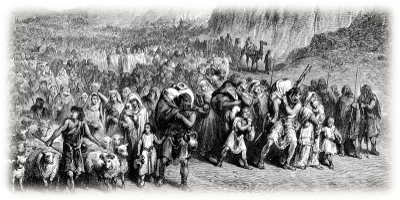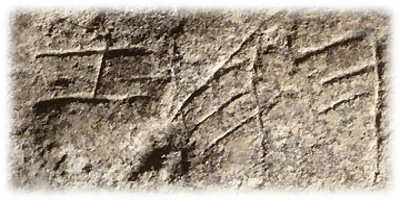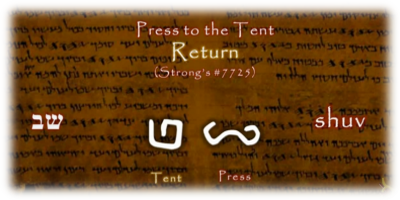Exodus is the most widely known story of the Hebrew Bible, but is fundamentally misunderstood. Most Jews are familiar with Exodus because we are commanded to retell the story every Passover. We dip vegetables in saltwater to recall the tears we shed as slaves in Egypt. We spill drops of wine to commemorate the plagues God inflicted on the Egyptians to deliver us to freedom. Perhaps most importantly, we celebrate the grand finale, when Moses descends from Mount Sinai carrying the written word of God, and the Nation of Israel is born. This is all quite familiar, but I am writing to retell an aspect of Exodus that is hidden, but essential: Exodus is a celebration of the birth of the alphabet.
Before we get to the alphabet, let’s consider the earlier writing system from which it arose: hieroglyphics. Developed over 5000 years ago, hieroglyphics is a magnificent and complex system of writing, containing over a thousand beautiful symbols. Its symbols were used in a variety of ways: Sometimes a symbol was used as a pictogram, in which a single symbol represented a specific word, for example, ![]() for an “eye” or
for an “eye” or ![]() for a “tooth” (a little Hammurabi humor). Sometimes, employing the “rebus principle,” two or more pictograms would be combined to phonetically indicate a word, for example,
for a “tooth” (a little Hammurabi humor). Sometimes, employing the “rebus principle,” two or more pictograms would be combined to phonetically indicate a word, for example, ![]()
![]() for “iron.” And occasionally a subset of symbols was used phonetically to sound out a name. This last feature of hieroglyphics was likely the inspiration for the alphabet.
for “iron.” And occasionally a subset of symbols was used phonetically to sound out a name. This last feature of hieroglyphics was likely the inspiration for the alphabet.
Somewhere between 1900 and 1500 BCE, the alphabetic script was conceived in Egypt. However, the inventors of the alphabet were not Egyptians, but Semitic people who were sojourning in Egypt.
Now, the phrase “Semitic people sojourning in Egypt'' might sound like a description of the ancient Israelites, but let’s be clear: the alphabet was invented before 1500 BCE, while the earliest archeological evidence of the Israelites comes much later around 1200 BCE. So, the most we can say is that Semitic people sojourned in ancient Egypt. Some were slaves. But some became scribes.
These Semitic scribes in Egypt made a revolutionary invention. Borrowing elements of hieroglyphics, they created their own, much simpler writing system. Here’s how it might have happened: they decided to employ the Egyptian’s technique of using symbols to represent the speech sounds of language, the so-called “alphabetic principle.” However, while hieroglyphics uses the alphabetic principle only occasionally, the Semitic scribes exclusively used symbols alphabetically. To this end, they chose one Egyptian symbol to represent each consonant of their language. Their choice of symbols was not random. For each consonant, they chose a symbol that depicts a word beginning with that consonant. For example, to represent the “b” sound, they chose the symbol for a house, because the Semitic word for “house” was “beth.” Similarly, to represent the “m” sound, they chose the symbol for water, because the Semitic word for “water” was “maim.” Using this process, they collected about thirty symbols, forming what is known as the Proto-Sinaitic Script.
Why was the Proto-Sinaitic Script revolutionary? Size. Whereas hieroglyphics required several hundred symbols to record the full range of human speech, the Proto-Sinaitic Script achieved this with less than thirty symbols. This efficiency of the Proto-Sinaitic Script offered two advantages: it lowered the bar for literacy, and it facilitated the spread of writing to other languages.
I suspect most ancient Egyptians knew a few symbols, like the symbols for the gods and pharaohs. But true literacy with hieroglyphics required learning hundreds of symbols, and mastering the rebus and alphabetic principles. The complexity of hieroglyphics probably put literacy out of reach for most people in pre-modern times. The Proto-Sinaitic Script greatly reduced the complexity of writing and democratized literacy. With a little bit of work, almost anybody can memorize thirty symbols, master the alphabetic principle, and become literate.
Not only did the alphabet allow literacy to spread to more members of society, but it also allowed literacy to spread among societies. This again relates to the small number of symbols in an alphabet. Speakers of other languages were able to easily adapt and adopt alphabetic scripts, and this is exactly what happened. The Proto-Sinaitic script first spread to Semitic-speaking peoples. Eventually, one of these groups, the Phoenicians, shared their script with the ancient Greeks. The Greeks made the innovation of adding symbols for the vowel sounds, transforming an “alphabetic script” into the first true alphabet. The Greeks in turn spread the alphabet to the rest of Europe, giving rise to both the Cyrillic Alphabets used in Eastern Europe and the Latin Alphabets used in Western Europe.
Now let’s return to Exodus: The ancient Israelites were slaves in Egypt. Then God delivered them from slavery, delivered them the written word, and the Nation of Israel was born. What is the history? Throughout the Second Millennium BCE, Semitic people sojourned in the land of Egypt. Some were made slaves, suffering immensely, and leaving a lasting mark on the Semitic psyche. Some became scribes, inventing the alphabet, and bestowing on their descendants the power of writing. The story of Exodus commemorates this Semitic history in ancient Egypt. A history of slavery, and a history of literacy. A history of oppression, and a history of transcendence.
To be clear, I do not believe that the Jews invented the alphabet – that honor belongs to their forerunners. Nevertheless, the Jews claimed the alphabet as their own, building their identity around the written word and connecting the birth of the Jewish people with the birth of the alphabetic script. The Jews were unique among ancient peoples in making a sacred book the centerpiece of their religion and culture. We dress the Torah in a robe and crown, because the Torah, the written word of God, is the only true king of the Jewish people. After the destruction of the Second Temple in 70 CE, a rabbinical decree mandated that all Jewish boys learn to read Torah, and thus Jews achieved universal literacy long before other peoples.
For this foundational attachment to the Torah, Jews have been known as "The People of the Book.'' The Jew's unusual literary obsession is well known. What is not well known is that Exodus, the Jew's origin story, which ends with the gift of the written word, occurred in the time and place that Semitic people invented the alphabet. At the very least, this is an incredible coincidence. But I believe the connection is more profound.
No, there is no parsha in Exodus in which Moses invents the Alphabet. Nevertheless, I believe there was a recognition, some hazy recollection in the Jewish collective memory, that what was delivered in Sinai was not only the written commandments, but writing itself. In ancient Egypt, divine inspiration gave birth to the alphabet, the very tool that allowed the Jews to transcribe their stories and begin a written conversation that has spanned thousands of years. Above all, Exodus is a story of hope and progress, reminding us that in our darkest moments, we might find salvation, along with a transformative gift.

Like what you’re discovering? Continue the journey from Bible reader to translator.
|






